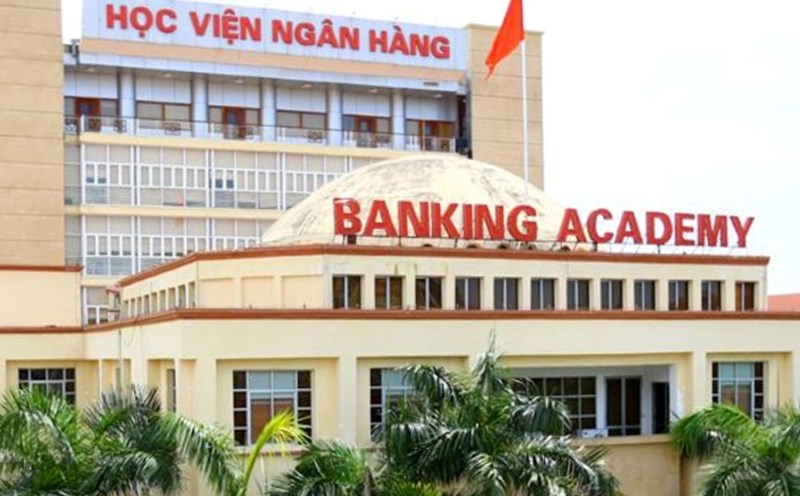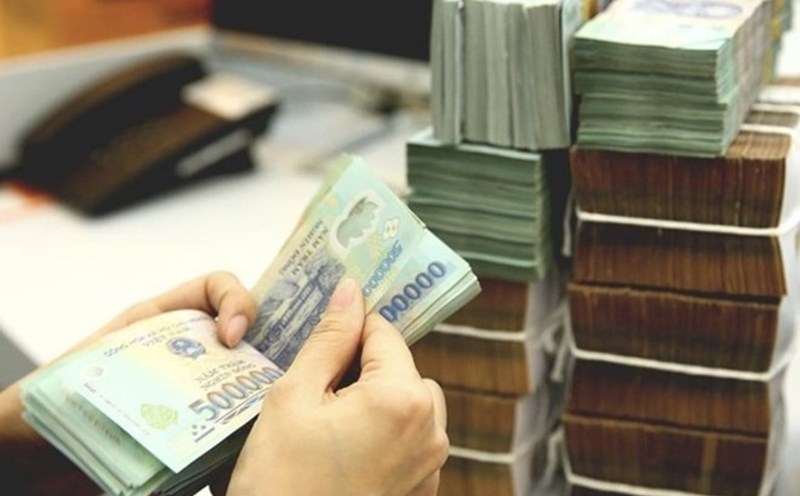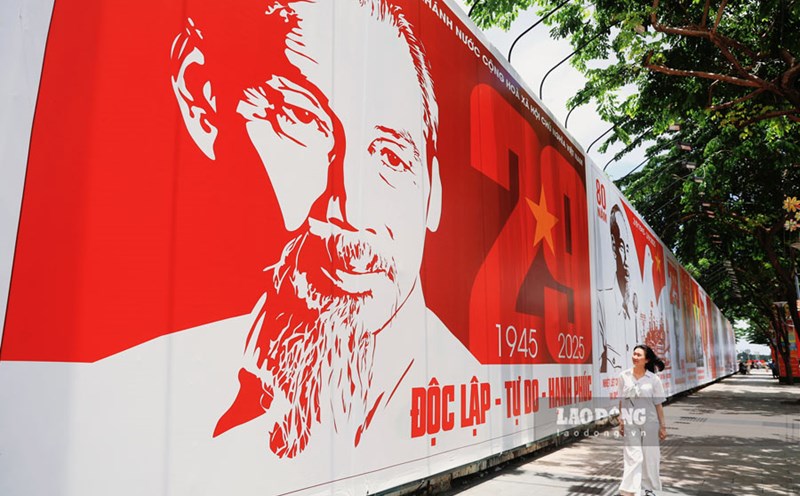Ladies and gentlemen, the State Bank is considered the gateway to the economy in terms of its role as a protector, coordinator and orienter for the stability and development of the national monetary and financial system, including macro regulation, inflation control, exchange rate management, banking supervision and system security. Over the past 74 years, since its establishment, along with the ups and downs of the nation's history, the State Bank of Vietnam has affirmed this special role, contributing significantly to creating a foundation of monetary independence, economic and financial sovereignty and maintaining stability in international integration. Reporter of the Voice of Vietnam interviewed Permanent Deputy Governor of the State Bank of Vietnam Dao Minh Tu to look back at the outstanding marks of the banking industry in the past, present and strategic vision to 2045.
would like to express my sincere thanks to Deputy Governor of the State Bank of Vietnam Dao Minh Tu for participating in the interview with The Voice of Vietnam. On the occasion of the 80th anniversary of the National Day of the Socialist Republic of Vietnam and the 74th anniversary of the establishment of the State Bank, I would like to share my perspective on the contributions of the State Bank of Vietnam to monetary policy management in the country's development over the past nearly 80 years.
- Along with the process of innovation, extensive international integration and national development, the activities of the banking industry have had profound innovations, especially innovations in the field of monetary policy planning and implementation.
The State Bank has also gradually improved and innovated monetary policy tools, getting closer to the operations of the modern Central Bank and in line with international practices, as well as the development trend of the country's economy. In addition, with a developing economy, the banking system is a major source of capital for the economy. Therefore, monetary policy has also promoted its role as one of the Government's important macro policies in promoting economic growth and towards rapid and sustainable economic development.
Throughout the above historical stages, the State Bank has always been steadfast and consistent with the goal of controlling inflation and stabilizing the macro economy. We also consider this a top priority goal in our monetary policy management process. Stable macro economy, controlled inflation is also a very important premise for economic development, as well as strengthening a solid foundation, maintaining the trust of investors, the business community, and people in the business environment, thereby helping to attract domestic investment capital, foreign investment capital, and optimal allocation of resources for the needs of stable development in the socio-economy.
Monetary policy management can be said to have contributed to achieving outstanding results in the country's socio-economic development process, in which we can summarize some of the main goals achieved. Firstly, it has successfully controlled inflation in line with the goals set by the National Assembly and the Government every year, as well as ensuring to keep inflation terms stable. Specifically, in the past 10 years and in the previous period, the targets to control monetary inflation have reached below the figure of 4.5% set by the National Assembly for many years. This is one of the largest and most important political goals, a fundamental foundation to stabilize the economy, as well as stabilize the value of money and create confidence for the economy and domestic and foreign investors. Second, we have ensured the liquidity of the credit institution system, supported the timely supply of capital, met the needs of production and business, and supported the socio-economic development process in all areas of the economy.
Third is that the monetary market operates relatively stably, the lending interest rate level is always controlled and operated in the direction of gradually reducing interest rates to support businesses, borrowers and directly support the growth of the economy.
Regarding exchange rates, we have been operating in the direction of ensuring stability and no disruption, ensuring a reasonable balance of the foreign exchange market, creating confidence for domestic investors and also creating confidence for stability and currency value, especially in exchange rates when they have been reasonably determined.
Fifth, in the context of increasing global risks as well as many countries in the world continuously having their rankings downgraded due to the negative impact of the recent COVID-19 epidemic, international credit rating organizations have highly appreciated the international credit rating for Vietnam because our macro foundation is relatively stable and has good growth potential. One of the goals and results that I believe monetary policy and banking operations in the past have achieved the basic features.
Dear Permanent Deputy Governor Dao Minh Tu, during the period of separation and prolonged war, the resistance war against the US to save the country was hard, how did the State Bank carry out its political and financial tasks to contribute to the common victory of the nation?
- Looking back at the great turbulent resistance war of our nation, for the banking industry, after the Geneva Agreement in July 1954, the two northern regions were temporarily divided, our northern region entered the construction of socialism, our southern region entered the national, democratic, and people's revolution, during this period the State Bank took on a very special mission and became the financial artery of the revolution, meeting the needs of building the country in the North as well as providing very effective support to the Southern battlefield, serving the resistance war, saving the country, and liberating the nation. Providing a source of foreign currency as well as financial resources is very important. For the North, which is a major support of the whole country, the banking system has maximized the role of a powerful tool of the Party and the State in the issue of currency regulation management, contributing significantly to stabilizing the economy as well as developing production and gradually building a foundation for banking activities to approach the socialist orientation.
It can be said that at this stage, banking activities have focused on capital mobilization, focusing on cash issues, creating liquidity as well as conditions for food production, and all fields that create a solid support for the South, as well as ensuring a stable life for the people, as well as the people in the Northern region. We see that through the synchronous issuance and implementation of credit finance policies in accordance with war conditions, the banking industry has also been proactive, mobilizing all resources among people, in cooperatives, in former national economic sectors, as well as the collective economy... Bank credit capital has been collected and even mobilized very actively with the enthusiasm and responsibility of each citizen, each economic organization.
That money goes to necessary places, especially in developing cooperative economies, agricultural economies, then factories and mechanics to go to key infrastructure projects of the economy during the initial industrialization period in the North. Credit activities for investment in production, agricultural credit, and savings credit have also contributed to the formation of an self-reliant, self-reliant economy, gradually escaping the manual subsidy mechanism and moving towards a socialist banking and finance system.
This is an extremely important period, a premise for the bank's further development. For the South as the front line, the silent soldiers of the banking industry also participated in the resistance war for national liberation. Although very quiet, in the field of monetary finance, there has also contributed great efforts and sacrifices.
The soldiers of the banking industry created resources and provided support resources for the Southern battlefield. All of these activities have written a legendary road, which is the road for secret money transfers, supporting financial resources for the Southern battlefield from 1959 to the day of liberation 1975. Looking back, it can be affirmed that the State Bank has successfully fulfilled its political and financial tasks and monetary tasks during the special period of the country.
Not only ensuring finance for the resistance war, the banking industry also contributed to creating a foundation of independence in currency, economic sovereignty, and finance, contributing to the Great Spring Victory in 1975, the young harvest of the river in one relationship and unifying money, unifying the hearts of the people. In the vision to 2045, when the country celebrates 100 years of independence, our country enters a new era, an era of national wealth and prosperity, what strategic goals does the State Bank set to realize these goals? Dear Deputy Thong Doc Dao Minh Tu?
- Aiming for the vision of 2045, the important milestone of celebrating 100 years of National Independence of our nation, the State Bank identifies the strategic goal of continuing to steadfastly follow the leadership of the Party, while promoting proactiveness, positivity, creativity and high responsibility, closely coordinating with ministries, branches and localities to best implement the common development goals of the country.
In that spirit, the State Bank has set a number of orientational goals for the banking industry to realize the aspiration to make Vietnam a rich, prosperous and high-income country by 2045. In the banking development strategy, we have developed and set out basic contents, one is to improve institutions, two is to continue monitoring, forecasting, and closely monitoring the domestic and international economic situation to advise and promptly report to the Government, the Prime Minister, and appropriate decisions in operating monetary policy proactively, flexibly, promptly, effectively, synchronously, harmoniously and closely coordinating with fiscal policy as well as other micro-economic policies to control inflation, contribute to stabilizing the micro-economy, supporting growth and how to achieve the double-digit target in the next term.
Third is credit management in line with macroeconomic developments and inflation, as well as the economy's ability to absorb capital to contribute to promoting economic growth.
Fourth, we continue to invest in upgrading the development of information technology infrastructure and modern payment infrastructure. In addition, strengthen inspection, examination and supervision to ensure security, safety and security of operations in the payment sector, as well as banking service activities to meet the increasingly high needs of businesses and people in the coming time.
It is known that 4 years ago, on the occasion of its 70th anniversary, the State Bank organized, compiled and issued a research work on the history of the Vietnamese currency. Can you please share about the meaning and value of this special project?
- Speaking of money, from the perspective of history, it is not simply a means of payment but also an example to reflect the political, economic, social and cultural context of each period. From ancient coins, feudal times to revolutionary silver bars issued during the resistance war and until the unified coins after 1975 until now, all tell stories about national independence, about the aspiration to unify the country, about the journey to build an independent and self-reliant monetary financial system of the nation.
The book on the history of the Vietnamese currency is one of the milestones of special significance for the banking industry that we have been preparing for and also devoted a lot of effort to for a long time. I am the curator of the project, but it can be said that this is a project of many collectives, scientists, researchers, money collectors and historical researchers in coordination; more than 50 people participated in the project to publish a book on the history of Vietnamese currency. That shows that this is a very elaborate and relatively strictly systematic research process that is fully scientific, documented, meticulously analyzed and evaluated for each currency in each period, each stage.
Especially in this history of the currency, we chose the time frame of 968 after Dinh Bo Linh deposed 12 ambassadors and unified the country, named the country Dai Co Viet until 970, when the first currency was issued under the name Thai Binh Huong Bao. This currency has been around for more than 1,000 years. We have gone through historical periods and stages and it can be said that thousands of coins have been issued throughout history, which have been compiled and collected in the book of the history of Vietnamese coins.
We believe that this is not only a scientific document but also a heritage of knowledge with special historical and cultural and economic value, vividly reflecting the country's development journey through the lens of money. We also hope that this book will not only be useful research documents for scientists and historical researchers for economics researchers but also a bridge of memories to help the public, especially the younger generation, better understand the values that our ancestors have worked hard to nurture. This is also a gratitude of the banking sector for the national history, and at the same time affirms the important role of the national currency in the cause of building and defending the Fatherland.
We see a very special point in the image of President Ho Chi Minh appearing throughout Vietnamese currency since it was issued by the Government of the Democratic Republic of Vietnam, now the Socialist Republic of Vietnam, from 1946 to present. What does this mean?
- Right after the country became independent, we had an independent currency and the Government issued an independent currency since 2014. Since then, 80 years have passed, every penny, whether large or small in value, has a portrait of President Ho Chi Minh. The image of Uncle Ho in every penny is the most beautiful image, looking at that image is to feel confidence and pride, because the image depicted in Uncle Ho's portrait on each penny is very beautiful. From the first currency issued in 1946 to the current polyme currency, it is a clear purpose-built choice that demonstrates the consistency of the national symbol as well as the political stability and unique identity of the Vietnamese currency. This is not simply a matter of honoring an individual in history but an affirmation of the core values that our Vietnamese people have chosen and preserved over the past decades.
The beloved Uncle Ho gave birth to the Democratic Republic of Vietnam, now the Socialist Republic of Vietnam, but more importantly, he not only has a historical role but also a symbol of morality, a culture and an ideology of the entire nation. In the eyes of our Vietnamese people, the image of Uncle Ho not only reminds us of a specific person but also represents the cultural identity, patriotism as well as the will for national independence as the ethics, methods and spirit of the Vietnamese people. It can be said that the image of Uncle Ho is both familiar and sacred in the minds of every Vietnamese person. Vietnam's currency with the image of Uncle Ho creates an extremely great value not only in terms of economic value, stability, and currency value, but also creates a value of trust, a value of pride, and a cultural value of a nation, expressed and miniaturized on our Vietnamese currency.
From the historical work of the Vietnamese currency, a very special publication of the banking industry, what message do you have for the younger generation in particular and the public in general?
- The work on the history of Vietnamese currency as I have said is not simply a book on currency research but can be considered a vivid cut of national history. In the process of forming money, we have seen the entire process of fighting for independence, protecting sovereignty and building the country of our ancestors over thousands of years.
Each currency has a representative tone for each period, each period. In the research dossier, each currency issued in each period, even in previous feudal dynasties, has nuances that reflect the characteristics of the socio-economic situation at that time, reflected on each currency.
I think that for today's young generation and the public, understanding the history of currency is also a way to understand the history of the country and the pride of our ancestors in the sacrifices and efforts to have an independent and independent monetary finance in the two great resistance wars of the nation, as well as in the current cause of building and developing socialism.
President Ho Chi Minh once said very simply and profoundly: "Our people must know our history, give us the original wall of the country of Vietnam". Understanding history, even the history through money, is also a way for us to have more pride and responsibility in preserving and promoting the values that our ancestors have built and nurtured. I hope that today's younger generations - those who are carrying the aspiration to build a country - will understand that each bill with the image of Uncle Ho today not only has material value but also carries the fruits of many previous generations, the soul of the Vietnamese people crystallized in those coins.
We also have to see the sacrifices, losses, and great contributions of generations of ancestors to achieve the overall independence and freedom of the nation as well as the independence in the national monetary and financial system. Knowing how to value the Vietnamese currency is also knowing how to maintain confidence to keep it stable for the present and as well as creating a future for the country to enter a period of take-off, entering a period of strong development.
I believe that Vietnamese currency with the image of the North Sea will forever be a confidence for every citizen in the country and also a source of pride for the world, a great spiritual value for us to reach the aspirations in the future.











